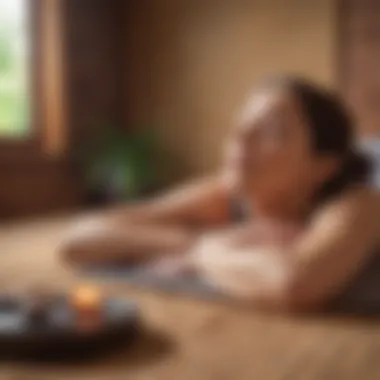Unlocking the Secrets of Effective Relaxation Techniques for Optimal Well-Being


Research Overview
Health Implications
In this section, the article delves into the crucial discussion of how effective relaxation techniques can profoundly impact one's health. Through exploring both the potential benefits and risks associated with relaxation practices, readers will gain a comprehensive understanding of their holistic effects. Furthermore, real-life examples illustrating how these findings can be integrated into daily routines will be provided.
Well-being Strategies
The practical dimension of relaxation methods will be detailed here, offering readers actionable tips derived from research insights. By providing advice on implementing positive changes to foster well-being, this section aims to empower individuals to incorporate relaxation techniques into their lives. Additionally, personal anecdotes or case studies will be shared to underscore the efficacy of these strategies.
Expert Insights
This segment delves into the analysis of expert opinions on the research findings related to effective relaxation techniques. Through a Q&A session with a pertinent expert in the field, readers will gain deeper insights into the nuances of relaxation practices and their impact on overall well-being.
Introduction
In delving into the realm of relaxation techniques for optimal well-being, it is imperative to recognize the pivotal role that relaxation plays in fostering overall health and wellness. Relaxation serves as a profound antidote to the stresses and strains of modern life, offering a sanctuary of calm amidst the chaos. By delving into this subject, we embark on a journey towards understanding the essence of tranquility and rejuvenation. The significance of this exploration lies in its ability to equip individuals with practical tools to navigate the turbulent waters of daily existence with serenity and grace.
Diving deeper, one uncovers the multifaceted benefits that effective relaxation techniques offer. From alleviating physical tension to soothing mental turbulence, the impact of relaxation reverberates across the entirety of one's being. By integrating these practices into our lives, we pave the way for enhanced cognitive function, improved emotional resilience, and a bolstered immune system. Consequently, the exploration of relaxation techniques transcends mere self-care; it becomes a cornerstone of holistic well-being.
Moreover, consideration must be given to the myriad forms that relaxation can assume. Whether through the gentle embrace of meditation, the rhythmic cadence of deep breathing exercises, or the mindful flow of yoga and Tai Chi, each modality offers a unique pathway towards inner calm and vitality. Understanding the diverse array of relaxation techniques empowers individuals to tailor their practices to suit their specific needs and preferences, amplifying the efficacy and depth of their relaxation experience. In essence, this exploration serves as a compass guiding us towards a state of equilibrium and optimal functioning.
Understanding Relaxation
Understanding relaxation plays a pivotal role in achieving optimal well-being. It involves delving deep into the essence of calmness and tranquility for enhancing mental and physical health. By grasping the concept of relaxation, individuals can proactively manage stress, anxiety, and overall well-being. This section will explore the significance of understanding relaxation techniques and how they contribute to a balanced lifestyle.


Definition of Relaxation
Relaxation can be defined as a state of profound calmness and peace where the mind and body are in a state of rest and free from tension. It encompasses various practices and techniques aimed at reducing stress, promoting well-being, and enhancing overall health. Understanding the definition of relaxation helps individuals recognize the importance of incorporating relaxation practices into their daily routine for optimal mental and physical health.
Importance of Relaxation
Relaxation holds immense importance in today's fast-paced and demanding world. It serves as a powerful tool for managing stress, improving sleep quality, boosting immunity, and fostering emotional well-being. Incorporating relaxation into daily life can have a profound impact on overall health, leading to increased productivity, better decision-making, and enhanced quality of life. Recognizing the significance of relaxation empowers individuals to prioritize self-care and well-being amidst life's challenges.
Benefits of Relaxation Techniques
The benefits of relaxation techniques are vast and impactful. From reducing muscle tension and lowering blood pressure to enhancing cognitive function and promoting emotional resilience, relaxation practices offer a myriad of advantages. By regularly engaging in relaxation techniques such as meditation, deep breathing, and progressive muscle relaxation, individuals can experience improved mental clarity, reduced anxiety, and a heightened sense of well-being. Understanding the benefits of these techniques is essential for harnessing their full potential in optimizing health and overall well-being.
Types of Relaxation Techniques
In the realm of enhancing well-being, the focus on relaxation techniques holds paramount significance. These techniques serve as vital tools in our modern and often stress-inducing lifestyles. By delving deep into various methods of relaxation, individuals can unlock a treasure trove of benefits for their mental and physical states. Types of relaxation techniques encompass a wide array of practices, each offering unique advantages and considerations. From traditional methods like meditation to more physical practices such as yoga and tai chi, the diversity in relaxation techniques allows individuals to personalize their approach based on preferences and needs.
Meditation
Meditation stands as a timeless practice that transcends cultural boundaries and has stood the test of time. Through the art of meditation, individuals can achieve a state of deep relaxation and heightened mindfulness. This practice involves focused attention and awareness, fostering mental clarity and emotional equilibrium. By incorporating meditation into a daily routine, one can experience reduced stress levels, improved concentration, and enhanced overall well-being. The simplicity yet profound impact of meditation make it a cornerstone in the realm of relaxation techniques.
Deep Breathing Exercises
Deep breathing exercises are simple yet powerful techniques that harness the connection between breath and relaxation. By engaging in controlled breathing patterns, individuals can effectively calm the nervous system, reduce anxiety, and promote a sense of tranquility. Deep breathing exercises are easily accessible and can be practiced anywhere, making them a convenient tool for relaxation in various settings. Incorporating deep breathing into daily life can lead to improved respiratory function, lowered blood pressure, and heightened feelings of inner peace.
Progressive Muscle Relaxation


Progressive Muscle Relaxation (PMR) offers a systematic approach to releasing physical tension and inducing a state of deep relaxation. This technique involves sequentially tensing and then relaxing different muscle groups in the body, promoting awareness of bodily sensations and fostering relaxation from head to toe. Through consistent practice of PMR, individuals can alleviate muscular stiffness, reduce chronic pain, and enhance overall bodily comfort. The structured nature of this technique makes it a valuable resource for those seeking profound physical relaxation.
Yoga and Tai Chi
Yoga and Tai Chi represent holistic practices that intertwine physical movement with mindfulness and breath awareness. These ancient disciplines not only promote flexibility, strength, and balance but also facilitate mental relaxation and stress reduction. By engaging in the flowing movements and meditative aspects of yoga and tai chi, individuals can cultivate a sense of harmony between mind and body. The gentle yet invigorating nature of these practices makes them ideal for individuals looking to enhance both physical health and emotional well-being.
Visualization Techniques
Visualization techniques tap into the power of mental imagery to induce relaxation and positive change. By guiding the mind through vivid and calming visualizations, individuals can create a tranquil inner space that promotes relaxation and inner peace. Visualization techniques can be tailored to individual preferences, allowing for personalization and creativity in the pursuit of relaxation. Whether envisioning serene landscapes or peaceful scenarios, the practice of visualization offers a pathway to enhanced relaxation and emotional well-being.
Practical Applications
One key element of practical applications is their ability to offer immediate relief from stress and tension. Incorporating relaxation into daily routines can help individuals unwind amidst the hustle and bustle of modern life, promoting a sense of calm and equilibrium. Moreover, practical applications allow for personalized customization based on individual preferences and needs, ensuring that relaxation practices are tailored to suit each individual's unique requirements.
Furthermore, practical applications bring to light the sustainable nature of relaxation techniques. By integrating relaxation into daily routines, individuals can create a sustainable lifestyle that prioritizes self-care and well-being. Consistency in practicing relaxation techniques can lead to long-term benefits, such as improved sleep quality, enhanced focus, and reduced anxiety levels.
Incorporating Relaxation into Daily Routine
The process of incorporating relaxation into daily routines is a transformative journey towards fostering a harmonious relationship between mind, body, and soul. It involves integrating mindfulness and self-care practices into everyday activities, allowing individuals to carve out moments of tranquility amidst the chaos of daily life.
One fundamental aspect of incorporating relaxation into daily routines is the establishment of a consistent practice. By setting aside dedicated time each day for relaxation exercises, individuals can imbue their daily rhythms with moments of peace and serenity. Whether it's through morning meditations, midday breathing exercises, or evening yoga sessions, creating a regular relaxation routine can significantly enhance overall well-being.
Additionally, incorporating relaxation into daily routines involves merging mindfulness with intentionality. By approaching relaxation practices with a deliberate and present mindset, individuals can fully immerse themselves in the experience, reaping the holistic benefits of relaxation on their mental and physical health. Mindful relaxation encourages individuals to be fully present in the moment, fostering a deeper connection with oneself and the surrounding environment.
Creating a Relaxation Sanctuary


Creating a relaxation sanctuary is an essential aspect of prioritizing self-care and mental well-being. A relaxation sanctuary serves as a sacred space dedicated to rejuvenation and inner peace, offering individuals a retreat from the stresses of daily life. By curating a tranquil environment tailored to one's preferences, individuals can enhance their relaxation practices and amplify their holistic well-being.
One key consideration in creating a relaxation sanctuary is the intentional design of the space. Selecting calming colors, incorporating soft lighting, and integrating nature-inspired elements can help cultivate a serene atmosphere conducive to relaxation. Personalizing the space with meaningful objects, such as inspirational quotes, soothing music, or comforting blankets, can further enhance the sanctuary's ambiance and foster a sense of comfort and security.
Moreover, a relaxation sanctuary provides individuals with an opportunity for introspection and mindfulness. By retreating to this sanctuary, individuals can engage in meditation, reflection, or quiet contemplation, allowing for a deeper exploration of the self and a reprieve from external stimuli. Regularly immersing oneself in a relaxation sanctuary can promote emotional balance, mental clarity, and overall well-being.
Utilizing Technology for Relaxation
Utilizing technology for relaxation opens up a realm of possibilities for enhancing one's well-being in the digital age. With the proliferation of wellness apps, guided meditations, and relaxation tools, technology can serve as a valuable resource for individuals seeking to prioritize their mental health and relaxation practices. By harnessing the power of technology mindfully, individuals can access a wealth of resources to support their well-being journey.
One advantage of utilizing technology for relaxation is the convenience and accessibility it offers. From virtual yoga classes to meditation apps, technology allows individuals to engage in relaxation practices anytime, anywhere, fitting seamlessly into their busy schedules. Additionally, technology provides a platform for connectivity and community, enabling individuals to participate in online support groups, mindfulness challenges, or virtual wellness workshops.
Furthermore, technology offers innovative solutions for enhancing relaxation experiences. Immersive guided imagery, biofeedback devices, and relaxation wearables can enrich traditional relaxation techniques, providing individuals with new avenues for stress relief and mental rejuvenation. By embracing technology mindfully and discerningly, individuals can leverage its potential to amplify their relaxation practices and improve their overall well-being.
Scientific Evidence
In this segment, we delve into the critical aspect of scientific evidence surrounding relaxation techniques. Scientific evidence provides a solid foundation for understanding the efficacy and benefits of various relaxation methods. By incorporating scientific research and studies, we can validate the actual impact of these techniques on our overall well-being. This section serves as a crucial bridge between theoretical knowledge and practical application, allowing readers to make informed decisions based on empirical data rather than mere speculation.
Scientific evidence plays a vital role in substantiating the claims and effectiveness of relaxation techniques. It offers a rigorous framework for assessing the outcomes of different methods, enabling us to distinguish between anecdotal evidence and scientifically proven results. By emphasizing the importance of evidence-based practices, individuals can feel more confident in adopting these techniques into their daily routine, knowing that they are supported by research grounded in sound scientific principles.
Moreover, scientific evidence helps us understand the underlying mechanisms through which relaxation techniques exert their influence on our mental and physical well-being. By dissecting the physiological and psychological processes involved, researchers can elucidate the intricate workings of these methods, shedding light on why and how they yield positive outcomes. This deeper comprehension not only enhances our appreciation for the benefits of relaxation but also empowers us to optimize our practice for maximum effect.
Furthermore, scientific evidence aids in debunking myths and misconceptions surrounding relaxation techniques, offering clarity amidst the plethora of information available. By debunking pseudoscientific claims and unsubstantiated beliefs, we can sift through the noise and focus on what truly matters – proven strategies that have a tangible impact on our health and wellness.
Conclusion
In this final segment of the article, we delve into the critical epitome of relaxation techniques. The Conclusion serves as the pinnacle that consolidates the essence of the entire discourse on optimizing well-being through effective relaxation methods. Within these 300-400 words, we meticulously scrutinize the intricacies of why a thorough understanding of relaxation and its application in daily life is paramount.
One of the key elements highlighted in this Conclusion is the profound impact that relaxation techniques have on mental and physical health. Through research studies, it has been affirmed that regular practice of relaxation methods can alleviate stress, reduce anxiety, and enhance overall well-being. By embracing these techniques, individuals embark on a transformative journey towards a healthier lifestyle.
Furthermore, the Conclusion accentuates the benefits of incorporating relaxation into daily routines. By establishing a dedicated relaxation sanctuary and utilizing technology to aid in relaxation, individuals can create an environment conducive to peace and tranquility amidst the hustle and bustle of modern life. This section emphasizes the practical applications of various relaxation techniques and underscores their efficacy in promoting a harmonious balance between body and mind.
Lastly, the Conclusion sheds light on the considerations individuals need to bear in mind when embarking on the journey of exploration through relaxation techniques. Patience, consistency, and openness to new practices are essential components in reaping the full benefits of these relaxation methods. By providing a comprehensive synthesis of the information presented throughout the article, the Conclusion reaffirms the significance of prioritizing relaxation in today's fast-paced world for optimal well-being and overall health.



